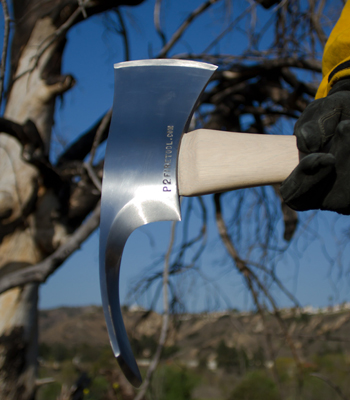 by Artek
by Artek
Details


P2 Improving the Pulaski
The Pulaski is a special hand tool used in wildland firefighting and trail building. The tool combines an axe and an adz in one head, similar to that of the cutter mattock, with a rigid handle of wood. The Pulaski is a versatile tool for constructing firebreaks, as it can be used to both dig soil and chop wood.
The invention of the Pulaski was credited to Ed Pulaski in 1911, although a similar tool was first introduced in 1876 by the Collins Tool Company. Ed Pulaski was famous for taking action to save the lives of a crew of 45 firefighters during the disastrous August 1910 wildfires in Idaho. His invention (or reinvention) of the tool that bears his name may have been a direct result of the disaster, as he saw the need for better firefighting tools. The Pulaski came into wide use by the Forest Service after 1913, and in 1920 the Forest Service began contracting for the tool to be commercially manufactured.
The new p2 design has added a sickle type cutting blade to the adze side of the head. This cutting edge allows rooting while digging with the adz, without turning over the tool to chop the roots with the bit axe. Using the sickle cutting edge to cut thru the roots, by first striking the root with the sickle blade, and then by leveraging the handle over to complete the cutting. When building fire breaks or constructing trails, this design reduces time and effort, along with preserving the axe blade for heavier roots, limbing and chopping.
In grubbing and clearing brush the p2 can be used in a horizontal slashing motion for quick clearing of dead and green brush. The underside of the adz gathers the brush, as the sickle edge cuts the material in a single motion.
The 1911 Pulaski is a great tool, but the new designed p2 combines the utility of the original tool with an additional cutting blade, complimenting the service of the tool.